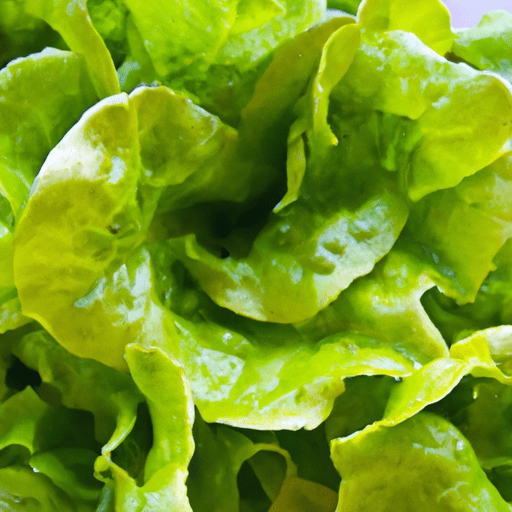Butterhead Lettuce Leaves: A Delicate Green Gem
Butterhead lettuce, also known as butter lettuce, is a true gem in the world of greens. Its tender, silky leaves and delicate flavor make it a favorite among salad enthusiasts and culinary connoisseurs alike. In this blog post, we will explore the wonderful world of butterhead lettuce leaves – from their taste and common uses in cooking to their nutritional value and intriguing history. Let’s dig in!
Taste and Texture:
One bite into a butterhead lettuce leaf and you’ll be captivated by its mild and sweet flavor. The distinctively soft and buttery texture of the leaves provides a delightful contrast to crunchier greens. The delicate nature of butterhead lettuce makes it perfect for creating light and refreshing salads, where it can truly shine.
Common Uses in Cooking:
Thanks to its versatility, butterhead lettuce leaves can be utilized in a myriad of culinary creations. Here are some popular uses:
Salads: Butterhead lettuce forms the foundation of classic salads. Its tender leaves provide an excellent base for a variety of toppings like cherry tomatoes, cucumbers, avocado, and roasted chicken. Toss it with a light vinaigrette or a creamy dressing to complement its flavor.
Lettuce Wraps: The pliable, cup-shaped leaves of butterhead lettuce are ideal for wrapping up a range of fillings. From savory stir-fried vegetables to spicy ground meats, the leaves lend a refreshing and crisp bite to every bite.
Sandwiches and Burgers: Instead of the usual iceberg lettuce, why not try butterhead lettuce in your next sandwich or burger? Its delicate texture won’t overpower the other ingredients, while adding a subtle freshness.
Nutritional Value:
While butterhead lettuce leaves are a culinary delight, they are also packed with essential nutrients. Here’s a breakdown of its nutritional value per 100g serving:
- Calories: 13
- Carbohydrates: 2.2g
- Fiber: 1.1g
- Protein: 1.35g
- Fat: 0.22g
- Vitamin K: 60% of the daily recommended intake
- Vitamin A: 74% of the daily recommended intake
- Folate: 10% of the daily recommended intake
Butterhead lettuce leaves are a great source of vitamins, particularly vitamin K and vitamin A, which are important for maintaining healthy bones, vision, and immune function. They are also low in calories and carbohydrates, making them an excellent choice for those following a calorie-conscious or low-carb diet.
Interesting History and Facts:
Butterhead lettuce dates back to ancient Egypt, where it was considered a prized vegetable by the pharaohs. Its cultivation later spread throughout the Mediterranean region and eventually reached North America.
The name “butterhead” originates from the lettuce’s soft, buttery texture and the way its leaves gently fold into a loose head.
Varieties like Boston and Bibb are popular types of butterhead lettuce in the United States.
Compared to other lettuce varieties, butterhead lettuce has a shorter shelf life. It’s best enjoyed within a few days of purchase to savor its exceptional quality.
Hydroponic farming methods have made it possible to grow butterhead lettuce year-round, ensuring a steady supply of this delicious green.
Conclusion:
Butterhead lettuce leaves offer a delicate taste, tender texture, and a myriad of culinary possibilities. Whether you choose to enjoy it in a salad, wrap, or sandwich, this green gem is sure to elevate your culinary creations with its mild and sweet flavor. So next time you’re seeking a refreshing and satisfying meal, don’t forget to indulge in the gentle allure of butterhead lettuce leaves!
Butterhead Lettuce Leaves
Origin: Butterhead lettuce, also known as Boston or Bibb lettuce, is believed to have originated in the Mediterranean region. It has been cultivated for centuries and was likely enjoyed by ancient civilizations such as the Greeks and Romans.
Common Uses: Butterhead lettuce leaves are often used in salads, sandwiches, and wraps. Their tender texture and mild, buttery flavor make them popular for creating fresh, crisp salads. They can also be used as a bed for other ingredients in sandwiches, or as a wrap for fillings such as chicken or tuna salad.
Nutritional Benefits: Butterhead lettuce is low in calories and rich in vitamins and minerals. It is a good source of vitamins A and K, as well as folate. It also contains small amounts of other essential nutrients such as vitamin C, potassium, and iron.
Unique Properties: One unique property of butterhead lettuce is its soft, buttery leaves. These tender leaves have a delicate texture that separates them from other lettuce varieties, such as romaine or iceberg lettuces. The leaves also have a slightly sweet and mild flavor.
Historical Significance: Butterhead lettuce has been grown and enjoyed for hundreds of years. Its popularity has grown over time, and it remains a staple in many cuisines around the world. It is considered one of the more delicate and flavorful types of lettuce and has earned a place in various culinary traditions.




Use the share button below if you liked it.
It makes me smile, when I see it.